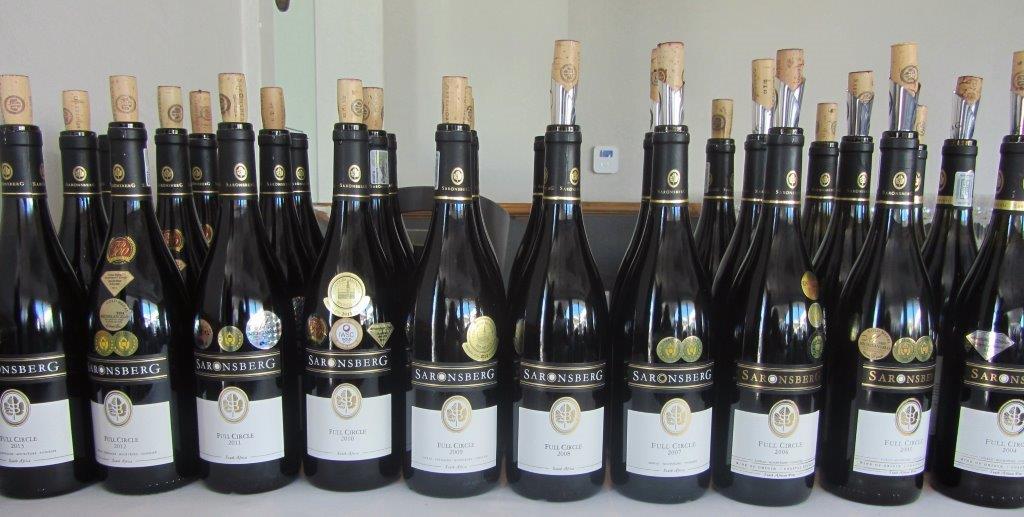JOURNEY OF A BLEND
There’s much to be learned from a vertical tasting, especially one that traces a wine since its maiden vintage, from young vines to older, and the increase in interest or complexity of the wine.
Such an exercise is particularly useful with red blends in South Africa, where new varieties as well as new vines are much in evidence. It helps when the winemaker has a good, basic idea of his (or her) goals and has the understanding to achieve them. Saronsberg’s Dewaldt Heyns is one such winemaker.
This Tulbagh farm was purchased by Nick van Huysteen in 2002; Heyns joined him the following year and has been in charge of the cellar since the maiden 2004 vintage. Such continuity lends greater credibility to whatever progress time marks.
The wine under scrutiny at a recent tasting was Saronsberg’s flagship red blend, Full Circle. The vintages spanned the period 2004 to 2013 (we did, in fact, taste in the opposite order).
In its current form, Full Circle is composed of Shiraz with Grenache, Mourvèdre and Viognier. Rhône varieties, yes, but Heyns refers to the wine as a Saronsberg rather than Rhône blend, his goal, as with flagships generally, being to reflect a sense of place rather than merely a varietal mix.
Heyns admits to being a Shiraz fanatic. He calls it his “safety net grape” as he’s so familiar with it. But he also believes the other varieties are well suited to Tulbagh’s warmer conditions. Tasting through the 10 wines, it’s clear he has an excellent grip on Shiraz, highlighting its elegance and crushed velvet texture; the tannins a presence but never in harsh dominance. “It’s everything about removing stems,” Heyns claims, “tannins derive from skins only.”
Vinification is tailored to each variety, with Shiraz left up to 26 days on the skins post fermentation, Mourvèdre finishing ferment in barrel and Viognier cold-fermented in barrel. A portion of Grenache receives whole-bunch fermentation.
Heyns is clever with oak too. Each vintage has been aged in 100 per cent new French oak, even 2004 from the youngest vines; 11 years on, it still drinks so well. If oak of choice remains Allier, coopers mainly Taransaud “with two or three others” and barrel size 300 litre, only the period in oak has increased: from an initial 16 months, to 18 months over the years 2005 to 2007, since when 20 months in total as a blend has been the norm. It’s a regime that complements and enhances the wine, one that carefully conceals the usual 14.5–15 per cent alcohol, and three to four grams of residual sugar.
Prior to 2008, Full Circle was headed by Shiraz, with Mourvèdre and Viognier in descending order, though actual percentages were dependent on vintage. With the exception of the maiden 2004, where the lightness of touch and freshness encourage its multi-dimensional character, the younger three – 2005, 2006 and 2007 – are less obviously blends, Shiraz being a more prominent feature. Vintage could play a role in this, 2005 and 2007 being dry and warm, whereas 2006, Heyns’ favourite of the older wines, is more elegant, with a finishing lift from its five per cent Viognier component.
By 2008, Heyns believed the Grenache bush vines were old enough to add positively to the wine (if any variety needs age it’s Grenache and, in terms of age, even now the Saronsberg vines are still infants). Considered one of the worst years for red wines thanks to inopportune summer showers and humidity, 2008 Full Circle, with its eight per cent Grenache input, is the most awarded of any year to date (the bottle in the photo belies this; there just wasn’t sufficient room for all the bling!). This proves once again how unwise it is to give a blanket vintage report.

The extra aromatic lift and spicy freshness imparted by Grenache with Viognier becomes even more apparent in the two youngest vintages – 2012 and 2013 (both really good red wine years). No doubt relative greater vine age – between nine and 12 years in 2013 – plays a role too. Heyns believes reining back Shiraz from its 80 per cent plus role to around 75 per cent, while Grenache has pushed up to double figures (the other two partners making up the balance), which has encouraged greater interest.
The tasting was fascinating: we learned what’s possible from a standing start; we saw how Heyns handled being out of his Shiraz comfort zone, especially once Grenache came on stream, how it forced him to look at the wine with new eyes and be willing to take risks. All is in search of the ‘phenomenal’ quality he strives for.
Where to from here? Older vineyards and the elegance Heyns seeks should help to guide the way forward to blends that echo of place and personality rather than just their current greater interest.
Like so many other South African winemakers getting to grips with red blends, Heyns is on a journey, one with no destination but even with slow, small steps forward, the Full Circle journey is full of promise and worth following.
– Angela Lloyd
-Angela Lloyd